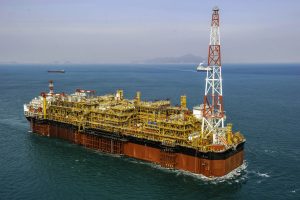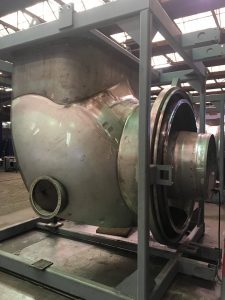Product development: engineering for manufacturing with Siemens Energy
What are the benefits of an integrated approach to product development, engineering, and production? Working with Siemens Energy, Antonius’ manufacturing for engineering know-how and experience was instrumental in creating an exhaust collector for a gasturbine package used at Floating Production Storage and Offloading (FPSO) vessels. This article looks at all phases of this process right up to prototype production and is based on an interview with Antonius’ engineer and projectmanager, Haico van der Goot.
Many people know Antonius as the premier manufacturer of (large) vessel heads and complex shapes but are often unaware of our other credentials. For select customers, Antonius provides a wide range of services that include concept application development, prototyping and engineering for manufacturing. Our unique knowledge of, experience with and ability to work with and shape large metal products have been deciding factors for several large multinational companies in Oil and Gas, Energy, Food and Shipbuilding. One of these companies is Siemens Energy who asked us to engineer and manufacture a new exhaust collector for use on FPSO vessels.
Engineering and manufacturing of a complex gas turbine exhaust collector for Siemens Energy
Siemens Energy contacted Antonius because of our work for a very well-known UK and US-based ship and aerospace systems builder. We have been developing and manufacturing exhausts with them for a great number of years and Siemens was looking to benefit from that experience:
“We simply got a phone call to invite us to present ourselves. Sometimes it’s just that simple,” says Haico van der Goot. “We presented our proven track record and unique strengths:
- focus on cost efficiency
- manufacturing flexibility
- a wide range of production techniques (including unique techniques such as the English wheel)
- ability to work with large metal workpieces (>10 meters)
- proven ability to work within the required tolerances
Already during that first meeting we were talking about the specifics of the project. Which turned out to be a good sign, in short time we signed an agreement.”
Engineering for manufacturing
“Siemens, of course, was well-prepared. We received a 3D-model that they had been working on for over a year and asked us: ‘Can you make this?’ I had to tell them that from a manufacturability point of view that it would cost millions to manufacture. The model they had created was beautiful, almost organic. Its flow was optimal, and it looked great, but it required automotive-level sheet metal work and that came with a cost Siemens was unable to pay. Of course, this is just where the process starts. It’s our job to come up with a ‘fit for purpose’ model that comes as close as possible to theirs but stays within cost constraints. And we did.”
Haico was in close contact with Siemens’ lead engineer during an iterative process in which Antonius would provide them with input for their flow analysis models. He would create new models based on known production methods or existing elements to ensure that any direction would be practical and within budget.
“If you must invent something new it is bound to be more expensive. But if you can reuse existing elements or constructions that we have experience with it is always more efficient. And what’s interesting about this project is that it turned out that a traditional production method (English wheel) was much more cost-efficient than any other modern production technique. We are one of a few metalworkers with sufficient experience with the technique to adequately judge if we could achieve the required tolerances with it. It allowed us to take a significant step toward an even more efficient model at great cost-efficiency.”
Download: Renewable energy and carbon capture
Using our experience in tanks for the transition to renewable energy in carbon capture and storage.Managing supply chain risk
“The initial design was using materials that immediately made me think about supply chain risk. A steel with a high percentage of nickel, for example, is much more dependent on the global flow of goods than a more common steel might be. Recent events have shown how right we were.
So, an important aspect of the collaboration is to review the use of materials and make an inventory of opportunities for mitigating risks and simplifying the supply chain. That means looking at available suppliers and options for materials that would still enable us to meet the specifications. This is a thread that also runs through the iterative engineering process.
Final model
Antonius worked closely with Siemens Energy during the design and engineering phases to arrive at the optimal model for the marine exhaust. Optimal meaning the iteration of the product that checked the most boxes, such as: balancing production cost, material availability and risks, assembly and installation cost, and weight.
“Every iteration would go back and forth; we would propose changes to the model – including a list of consequences for, for example, material and production costs – that they could run through their CFD analyses. The provided feedback would be discussed and incorporated before moving to a different aspect of the product. Once we had found the right balance, we had what we call the ‘final model’, and we started making the technical drawings that would finalize the product design for this phase.
This is an intense process that makes full use of Antonius’ engineering and manufacturing know-how. For our customers, working with Antonius has the additional advantage that we have all manufacturing capabilities and a wide range of production techniques in house. Once the model is finalized, we can immediately schedule prototype production, knowing that the production process is well within our capabilities. Often, we have informed clients of delivery times already.”
Would you like to know more about Antonius’ engineering for manufacturing approach and our added value during product design and development? Contact us via Rob Derix on rderix@antonius.nl or +31 (0)475 439 000 and we are happy to tell you everything you would like to know.

